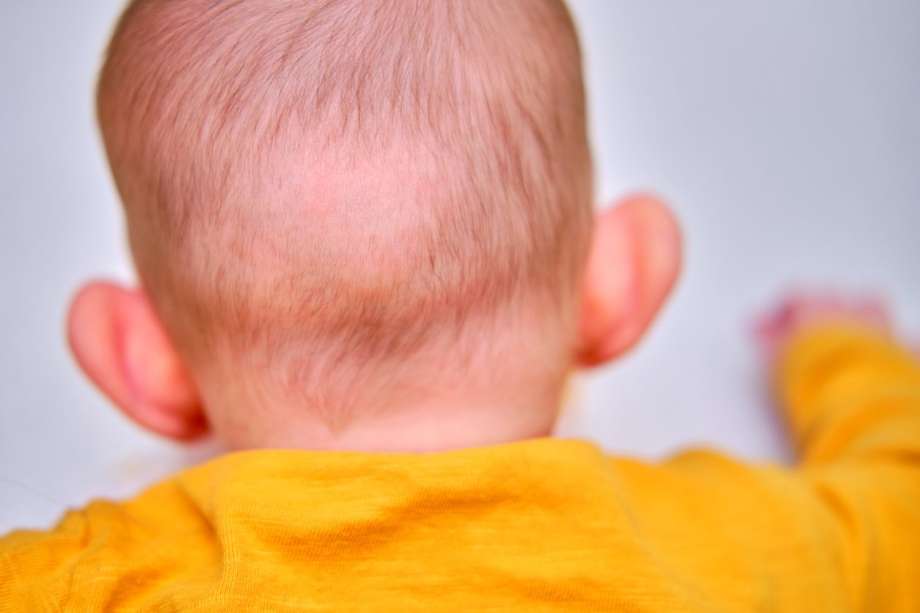What Is Dolichocephaly in Newborns?

It’s common for a baby to be born with a slightly misshapen head. The bone plates in a baby’s skull aren’t fused together yet and can shift around. This allows the baby’s head to squeeze through the birth canal during labor. In addition, their heads are supposed to be moldable to prepare for the amount their brains will grow in the first 12 months of life.
Over time, a baby’s head will slowly round out and the head deformity diminishes. However, if your baby’s skull shape looks severely misshapen, they may have a condition called dolichocephaly. This article explains what dolichocephaly is, its causes, potential complications, and the types of treatments that are available.
You may have also heard the term plagiocephaly before. This is when the head is flattened on just one side, causing it to look asymmetrical. With plagiocephaly, the ears may also be misaligned. Sometimes the face and forehead may bulge a little on the flat side.
What is Dolichocephaly?
Positional skull deformity occurs when a baby stays in the same position for a long time. Depending on the position they are in, this can cause their head shape to alter.
The American Academy of Pediatrics (AAP) states that for most babies (about 80%), a positional skull deformity occurs during the first 4 to 12 weeks of life. It is during this time when babies are the least mobile and are unable to roll, change positions, or sit up on their own.
In babies with dolichocephaly (scaphocephaly), the positional skull deformity is characterized by a head shape that is longer and narrower, similar to a boat. The shape is often caused during their time after birth and has been found to be more common among babies with a prolonged stay in the neonatal intensive care unit (NICU).
Causes of Dolichocephaly

It is unknown whether there are specific risk factors associated with dolichocephaly. It can develop in babies who stay in a particular position for an extended amount of time.
There are two main causes of dolichocephaly:
1. Extended side-lying position
Dolichocephaly is also referred to as NICUcephaly because most cases occur in preterm infants who are born at less than 32 weeks gestation and have spent a significant amount of time in the NICU.
The side-lying position is preferred for NICU infants because it helps prevent health complications by reducing reflux, apnea and bradycardia. However, the baby’s extended hospitalization stay can cause skull flattening on each side and lead to dolichocephaly.
2. Craniosynostosis
Craniosynostosis is a congenital birth defect in which the sutures in an infant’s skull close too early before the brain is completely formed. Sutures are the spaces filled with a flexible material between the bone plates of a baby’s skull. When this happens, the brain is unable to grow in the parts of the skull that joined prematurely but continues to grow in the other parts.
The brain will grow to its normal size; however, this can cause a cranial deformity. In some cases where more than one suture fuses too early, there may not be enough room for the brain to properly grow. This can cause pressure to build up in the skull. Surgery is required as it can cause developmental delays, seizures, blindness, and cognitive impairment.
The prevalence of craniosynostosis in the United States is estimated to be 1 in every 2,500 babies.
In dolichocephaly, sagittal synostosis is most often the cause. The sagittal suture is located at the top of the infant’s head near its soft spot and runs along to the back of the head.
Complications of Dolichocephaly
The AAP states that for the majority of infants, a misshapen head does not pose a serious health risk. Typically, positional skull deformities do not require surgery as they do not impact brain growth and cognitive development. The cause for concern is mainly aesthetic reasons.
However, long-term consequences have been found to be associated with severe cases of dolichocephaly. Some of these include motor asymmetries, delayed reaching skills, reduced flexibility in scapular retractors and tightness in the spinal extensors. More research needs to be conducted to fully understand the long-term effects.
In addition, a severe head deformity can lead to craniofacial abnormalities. As a baby grows up, this can affect their self-esteem and cause social issues in adult life.
It’s important to speak to your pediatrician if you are concerned about your baby’s head deformity. They can help you understand the impact of dolichocephaly on your baby’s health and well-being and may recommend surgery or other treatment options.
Medical Intervention

Mild cases of dolichocephaly usually resolve on their own. However, it’s important to discuss with your doctor or healthcare professional whether your baby’s condition will require medical intervention. There are three types of treatment for deformed head shapes:
1. Helmet Therapy
Helmet therapy is often recommended when an infant’s misshapen head has not resolved by 5 to 6 months of age. A molding helmet is custom-made by a specialist to fit your baby’s head. Your baby wears the helmet over a period of time and it helps reshape their head.
2. Physical Therapy
A pediatric physical therapist conducts an evaluation of your baby’s motor skills, and head and neck control. Then they will teach you stretching and positioning exercises to prevent developmental delays.
3. Surgery
Surgery should only be considered in severe cases of dolichocephaly where all the other options have not resolved the issue. A pediatric neurosurgeon and plastic surgeon should be consulted to determine the most appropriate course of action.
Tips to Prevent a Head Deformity

When a head deformity is found early enough, there are some things that you can do to allow your baby’s head to grow into a proper shape.
- Limit the amount of time your baby spends in a carrier: When your infant is in a car seat, stroller, baby swing or bouncy chair too long, it can put pressure on your baby’s head and cause the skull to misshapen.
- Do plenty of tummy time: Putting your baby on their back to sleep in a supine position can help decrease their risk of SIDS (Sudden Infant Death Syndrome); however, during their waking hours, it’s crucial your baby gets to play on their tummy. Tummy time allows your baby to increase muscle tone in their back, neck, shoulders, hips and arms and prepares them to roll, sit up, crawl and change positions on their own.
- Change feeding positions regularly: This prevents the baby’s head from being in the same position and helps it grow into a normal shape.
- Put your baby down to sleep on different ends of the crib: Different ends of the crib have different lighting and objects that your baby will look at. This can encourage more varied head movements and help reduce the pressure on the same spot on the skull.

